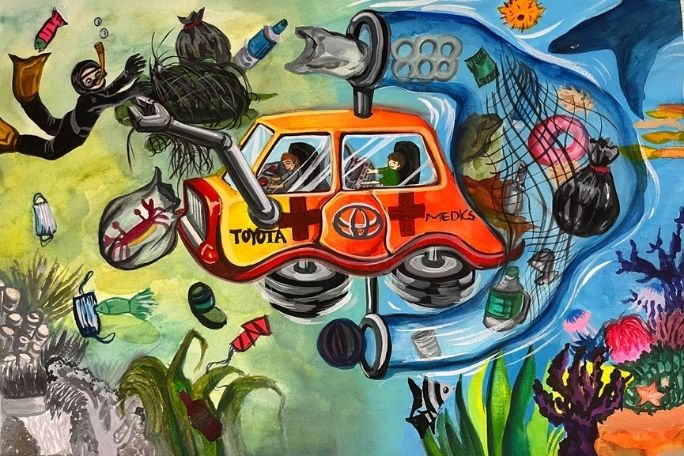Lesson summary
In this lesson students design a dream car and create an artwork to represent their ideas that will be submitted to the Toyota Dream Car Art Contest. This contest encourages and inspires creative expression and imagination in students – some amazing ideas are born from dreams! Students will examine the winners of last year’s Toyota Dream Car Art Contest, and evaluate the messages and visual conventions displayed in these artworks. Students then work as a class to brainstorm some ideas for their own dream cars, and then work independently to create their own dream cars artworks.
Learning intentions:
Students will...
- understand what a dream (aspiration) is and why we should dream
- explore things that a dream car could do
- imagine a range of dream cars that can help people and our environment
- work as artists to convey messages and meaning in their artworks
Success criteria:
Students can...
- analyse in intent of artworks created by students their own age
- use simple elements of social and environmental sustainability in a design project
- utilise artistic creativity in their design project
Lesson guides and printables
Lesson details
Curriculum mapping
Australian curriculum content descriptions:
Years 3 and 4 Visual Arts:
- Explore ideas and artworks from different cultures and times, including artwork by Aboriginal and Torres Strait Islander artists, to use as inspiration for their own representations (ACAVAM110)
- Use materials, techniques and processes to explore visual conventions when making artworks (ACAVAM111)
- Present artworks and describe how they have used visual conventions to represent their ideas (ACAVAM112)
Years 5 and 6 Visual Arts:
- Explore ideas and practices used by artists, including practices of Aboriginal and Torres Strait Islander artists, to represent different views, beliefs and opinions (ACAVAM114)
- Develop and apply techniques and processes when making their artworks (ACAVAM115)
- Explain how visual arts conventions communicate meaning by comparing artworks from different social, cultural and historical contexts, including Aboriginal and Torres Strait Islander artworks (ACAVAR117)
Years 3 and 4 Design and Technologies:
- Recognise the role of people in design and technologies occupations and explore factors, including sustainability that impact on the design of products, services and environments to meet community needs (ACTDEK010)
Years 5 and 6 Design and Technologies:
- Examine how people in design and technologies occupations address competing considerations, including sustainability in the design of products, services, and environments for current and future use (ACTDEK019)
Syllabus outcomes: VAS2.1, VAS2.2, VAS3.1, VAS3.2, VAS3.3, VAS3.4, ST2-11LW, ST2-14BE, ST2-15I, ST2-16P, ST3-14BE, ST3-15I, ST3-16P.
General capabilities: Critical and creative thinking.
Cross-curriculum priority: Sustainability OI.8, Ethical Understanding.
Relevant parts of Year 3-4 Visual Arts achievement standards: Students discuss how they and others use visual conventions in artworks. They use visual conventions, techniques and processes to communicate their ideas.
Relevant parts of Year 5-6 Visual Arts achievement standards: Students explain how ideas are represented in artworks they make and view. They use visual conventions and visual arts practices to express a personal view in their artworks. They demonstrate different techniques and processes in planning and making artworks.
Relevant parts of Year 3-4 Design and Technologies achievement standards: Students explain how products, services and environments are designed to best meet needs of communities and their environments.
Relevant parts of Year 5-6 Design and Technologies achievement standards: Students describe competing considerations in the design of products, services and environments, taking into account sustainability.
Time required: 120 mins +
Level of teacher scaffolding: High – oversee discussion and brainstorm. Assist students with creating artworks. Submit entry forms.
Resources required
- Student Worksheet – one copy per student OR computers/tablets to access the online worksheet
- Device capable of presenting a website to the class
- Paper measuring no larger than 400mm x 550 mm (15.7-21.7in.) or A3 in size
- Drawing materials, including but not limited to coloured pencils, pens/markers, crayons, paints, watercolour paints, etc
- Sticky notes
Skills
This lesson is designed to build students’ competencies in the following skills:
- Communication
- Collaboration
- Creativity
- Problem Solving
Additional info
The Toyota Dream Car Art Contest usually commences late October to early November and concludes late to early March. Find up-to-date entry details, prizes and full terms and conditions here.


Welcome back!
Don't have an account yet?
Log in with:
By signing up to Cool.org you consent and agree to Cool's privacy policy to
store, manage and process your personal information. To read more, please see
our privacy policy here(Opens in new tab).
Create your free Cool.org account.
Many of our resources are free, with an option to upgrade to Cool+ for premium content.
Already have an account?
Sign up with:
By signing up to Cool.org you consent and agree to Cool's privacy policy to
store, manage and process your personal information. To read more, please see
our privacy policy here(Opens in new tab).